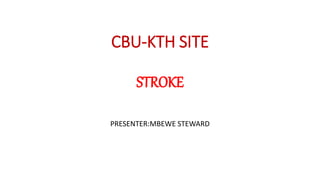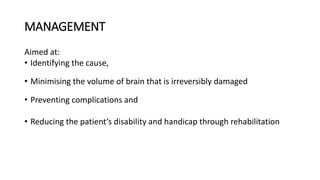This document provides an overview of stroke, including:
- Stroke is defined as rapid neurological deficit caused by focal brain infarction or hemorrhage.
- Risk factors include hypertension, atrial fibrillation, diabetes, hyperlipidemia, and smoking.
- Strokes are either ischemic (85%) due to thrombosis or embolism, or hemorrhagic (15%) due to bleeding.
- Clinical features depend on the location of brain injury but may include weakness, speech problems, visual issues, and headache.
- Investigations include brain imaging (CT or MRI), blood tests, and cardiac workup to determine the cause.
- Treatment involves supportive care, thrombolysis




















































